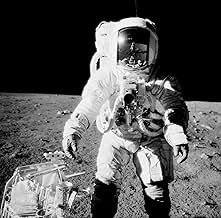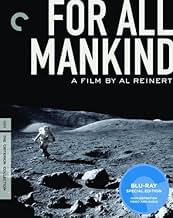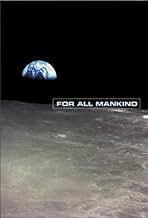PUNTUACIÓN EN IMDb
8,1/10
6,8 mil
TU PUNTUACIÓN
Una mirada en profundidad a varias misiones de alunizaje de la NASA, comenzando con el Apolo 8.Una mirada en profundidad a varias misiones de alunizaje de la NASA, comenzando con el Apolo 8.Una mirada en profundidad a varias misiones de alunizaje de la NASA, comenzando con el Apolo 8.
- Nominado para 1 premio Óscar
- 3 premios y 3 nominaciones en total
Jim Lovell
- Narrator - Apollo 8, Apollo 13
- (voz)
- (as James A. Lovell Jr.)
Ken Mattingly
- Narrator - Apollo 16
- (voz)
- (as T. Kenneth Mattingly II)
Russell Schweickart
- Narrator - Apollo 9
- (voz)
- (as Russell L. Schweickart)
Eugene Cernan
- Narrator - Apollo 10, Apollo 17
- (voz)
- (as Eugene A. Cernan)
Charles Conrad
- Narrator - Apollo 12
- (voz)
- (as Charles P. Conrad Jr.)
Richard Gordon
- Narrator - Apollo 12
- (voz)
- (as Richard F. Gordon Jr.)
Alan Bean
- Narrator - Apollo 12
- (voz)
- (as Alan L. Bean)
Jack Swigert
- Narrator - Apollo 13
- (voz)
- (as John L. Swigert Jr.)
Stuart Roosa
- Narrator - Apollo 14
- (voz)
- (as Stuart A. Roosa)
James Irwin
- Narrator - Apollo 15
- (voz)
- (as James B. Irwin)
Charles Duke
- Narrator - Apollo 16
- (voz)
- (as Charles M. Duke Jr.)
Harrison Schmitt
- Narrator - Apollo 17
- (voz)
- (as Harrison H. Schmitt)
Buzz Aldrin
- Self
- (metraje de archivo)
Bill Anders
- Self
- (metraje de archivo)
Neil Armstrong
- Self
- (metraje de archivo)
Stephen Bales
- Self
- (metraje de archivo)
- (as Steve Bales)
Frank Borman
- Self
- (metraje de archivo)
Argumento
¿Sabías que...?
- CuriosidadesThe staging footage was captured because NASA wanted to document the flight process of an unmanned Saturn flight for feedback in case there was a failure for engineers to look at footage to see what went wrong. Cameras were mounted in strategic locations, kicking on at critical moments to document the staging process for less than half a minute. After completion, the light-tight canisters containing the exposed film were jettisoned, dropping to earth with homing beacons and parachutes inside protective heat shields. Air Force C-130 transport planes, towing gigantic nets, recovered the canisters in the southern Atlantic Ocean.
- PifiasThe opening of the documentary incorrectly states that: "During the four year between December 1968 and November 1972, there were nine manned flights to the moon." The last lunar mission, Apollo 17, took place in December 1972.
- Citas
Charles M. Duke Jr.: The only bad part about zero gravity in Apollo was goin' to the bathroom. We had a very crude system. For your feces it was a bag, and you put this bag in the right position. So you go, but the only thing is that nothing goes to the bottom of the bag in zero gravity.
- Créditos adicionalesFilmed on location by the United States National Aeronautics and Space Administration.
- Banda sonoraSirens
Courtesy of Opal Records (Music For Films III)
Written and Performed by Daniel Lanois and Brian Eno
Licensed by Upala Music/Hamstein (BMI)
Reseña destacada
This film is a retelling of arguably one of the greatest achievements of the human race. In summer 1969, on a bright sunny morning, a group of astronauts led by commander Neil Armstrong climbed into the Saturn V rocket ready for its first flight. Not even 70 years had passed since planes had been invented. About 1 million people had gathered at the Kennedy Space Center in Florida to witness the once in a lifetime event, and millions more watched the entire thing on television. This film attempts to recapture some of that excitement that must have been everywhere on that day. It features interviews with the people who were brave enough to leave Earth in order to visit a place that has always watched over humanity, quite literally. At some points, it feels almost like a horror movie because nobody in the rocket or back on Earth knew if the thing would just blow up in flight for no reason, and the inside of the rocket module looks incredibly small. One of the astronauts says how strange of an experience it was and how going to the moon isn't like travelling to any other place, because when you travel somewhere, you have various landmarks to tell how far you got. On the moon mission, he says you leave Earth, pass an unimaginably large area of absolutely nothing for a few days, and suddenly, you're at the moon. There is nothing in between. The fact that the moon is only about a quarter of a million miles from Earth while stars are so far away you couldn't reach them even if you travelled your whole life makes it even more daunting. After the module lands on the surface, Neil says his famous line, and we see more very impressive shots of what the surface of the moon looks like. It has a depressing feel to it because the only colors are gray and black, but at the same time, it has a triumphant feel. The moon has been waiting thousands of years for people to go there, and the men reflect this by saying even though they knew they might not come back, they felt at home there. The soundtrack for this movie also gives it a sad feel that makes you realize how vast and empty space is. They show many things that seem unbelievable, even to experienced astronauts, such as small dots of light on the African continent (they're actually fires started by tribes), and having their food float in zero gravity when they're trying to eat. This is something that everyone should see at least once, because it discusses one of humanity's biggest accomplishments. To this day it's strange to think it was done in the 60s. Not many people have been to space, so you will be amazed watching this.
- nickenchuggets
- 5 jun 2021
- Enlace permanente
Selecciones populares
Inicia sesión para calificar y añadir a tu lista para recibir recomendaciones personalizadas
- How long is For All Mankind?Con tecnología de Alexa
Detalles
- Fecha de lanzamiento
- País de origen
- Idioma
- Títulos en diferentes países
- National Geographic: For All Mankind
- Localizaciones del rodaje
- Sea of Tranquility, The Moon, Space(Apollo 11 landing site)
- Empresas productoras
- Ver más compañías en los créditos en IMDbPro
Taquilla
- Recaudación en Estados Unidos y Canadá
- 770.132 US$
- Fin de semana de estreno en EE. UU. y Canadá
- 33.777 US$
- 5 nov 1989
- Recaudación en todo el mundo
- 770.366 US$
- Duración1 hora 20 minutos
- Color
- Mezcla de sonido
- Relación de aspecto
- 1.37 : 1
Contribuir a esta página
Sugerir un cambio o añadir el contenido que falta

Principal laguna de datos
By what name was For All Mankind (1989) officially released in India in English?
Responde


































